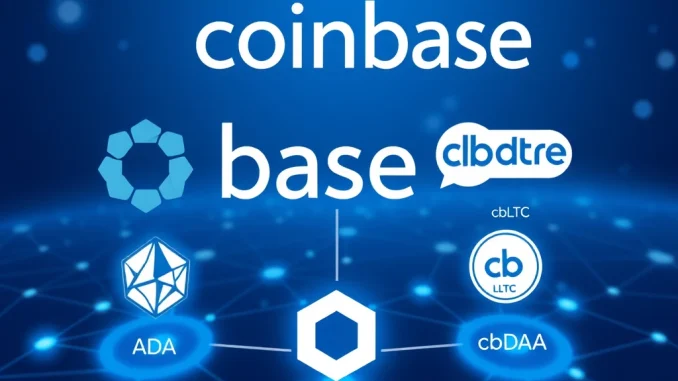
Big news is circulating in the crypto world! The Coinbase Base network, Coinbase’s own Ethereum Layer-2 solution, has just announced a significant expansion. According to reports, specifically from Unfolded on X, Coinbase has launched wrapped versions of two popular cryptocurrencies: Cardano (ADA) and Litecoin (LTC). These new assets, known as cbADA and cbLTC, are now live on the Base network, potentially opening up new avenues for users.
What Exactly Are cbADA and cbLTC?
At their core, cbADA and cbLTC are wrapped tokens. Think of a wrapped token as a representation of another cryptocurrency that lives on a different blockchain. In this case:
- **cbADA:** A token on the Base network whose value is pegged 1:1 to the price of native ADA on the Cardano blockchain.
- **cbLTC:** A token on the Base network whose value is pegged 1:1 to the price of native LTC on the Litecoin blockchain.
These tokens are typically created by locking the underlying asset (ADA or LTC) in a vault or smart contract and then minting the corresponding wrapped token (cbADA or cbLTC) on the target chain (Base). This mechanism allows assets from one blockchain to effectively participate in the ecosystem of another.
Why Bring These Assets to the Base Network?
The launch of cbADA and cbLTC on the Base network is a strategic move aimed at increasing interoperability and utility. The Base network, being an Ethereum Layer-2, benefits from Ethereum’s security while offering lower transaction costs and faster speeds compared to the Ethereum mainnet or even the native Cardano and Litecoin chains for certain operations. By wrapping ADA and LTC, Coinbase is essentially bringing the liquidity and value of these large-cap assets into the Base ecosystem. This allows holders of ADA and LTC to potentially engage with decentralized applications (dApps) built on Base without needing to bridge their native assets in complex ways or incur high fees.
Understanding the Power of Wrapped Tokens
The concept of Wrapped tokens is crucial for bridging isolated blockchain ecosystems. Without them, an ADA holder couldn’t easily use their ADA to participate in a lending protocol or decentralized exchange built on an Ethereum-compatible chain like Base. Wrapped tokens solve this by creating a parallel asset that conforms to the technical standards of the target chain (like ERC-20 for Base). This expands the potential use cases for the underlying asset significantly, allowing it to interact with a whole new set of dApps and financial primitives available on the Base network.
Benefits for Users and the Ecosystem
What does this development mean for you and the broader crypto space? Here are some potential benefits:
- **Access to Base DeFi:** Holders of ADA and LTC can now potentially use cbADA and cbLTC within decentralized finance protocols on Base, such as decentralized exchanges (DEXs), lending platforms, and yield farming opportunities.
- **Lower Transaction Costs:** Interacting with assets on a Layer-2 like Base is typically much cheaper than transacting on Layer-1 chains like Ethereum, Cardano, or Litecoin, especially for frequent operations.
- **Increased Utility for ADA and LTC:** This move provides ADA and LTC holders with more options beyond their native chains, potentially increasing demand and utility for these assets.
- **Ecosystem Growth:** The inclusion of major assets like ADA and LTC helps grow the overall liquidity and activity on the Base network, attracting more users and developers.
- **Simplified Access via Coinbase Base:** For users already within the Coinbase ecosystem, accessing and using these wrapped tokens on Base is likely to be more seamless than navigating complex cross-chain bridges independently.
What Are the Potential Downsides?
While the launch is exciting, it’s important to consider potential risks:
- **Wrapping Mechanism Risk:** The security and integrity of the mechanism used to wrap and unwrap the tokens are critical. If the custodian or smart contract holding the native assets is compromised, the value peg could break.
- **Smart Contract Risk on Base:** Interactions with dApps on the Base network carry smart contract risks inherent in any decentralized application.
- **Liquidity:** Initial liquidity for cbADA and cbLTC on Base might be low, potentially leading to higher slippage on trades.
- **Centralization Concerns:** If the wrapping process relies heavily on a single entity (like Coinbase), it introduces a point of centralization risk compared to using the native, decentralized assets.
Looking Ahead
The introduction of cbADA and cbLTC on the Base network is a notable step in bridging different parts of the crypto landscape. It signals Coinbase’s commitment to building out the Coinbase Base ecosystem and increasing the utility of assets within its orbit. We may see more wrapped assets launched on Base in the future, further expanding the possibilities for users looking to leverage Layer-2 benefits with a wider range of cryptocurrencies.
Summary
Coinbase’s launch of cbADA and cbLTC on its Base network is a significant development for the platform and for holders of Cardano and Litecoin. By introducing these Wrapped tokens, Coinbase is facilitating greater interoperability, potentially unlocking new DeFi opportunities on Base with lower costs. While risks associated with wrapping mechanisms exist, this move underscores the growing importance of Layer-2 solutions and cross-chain compatibility in the evolving crypto landscape. Keep an eye on the Coinbase Base ecosystem as it continues to grow!



